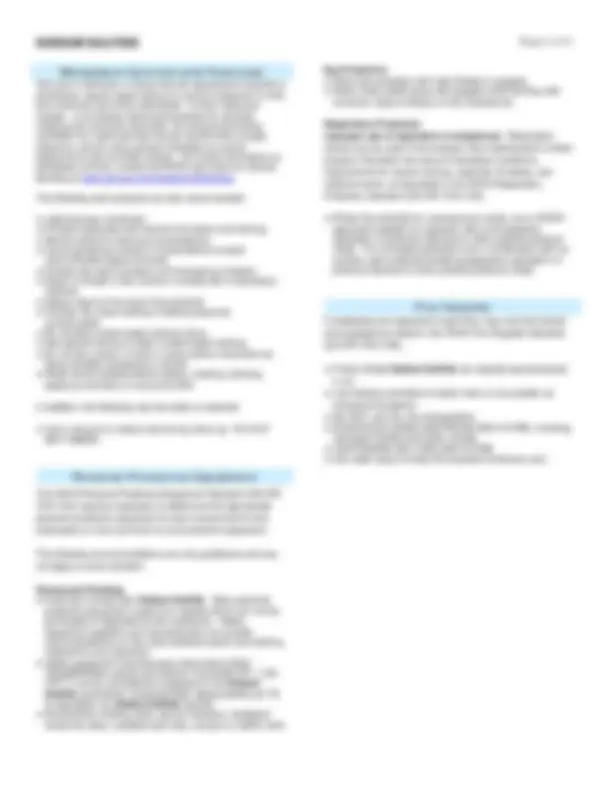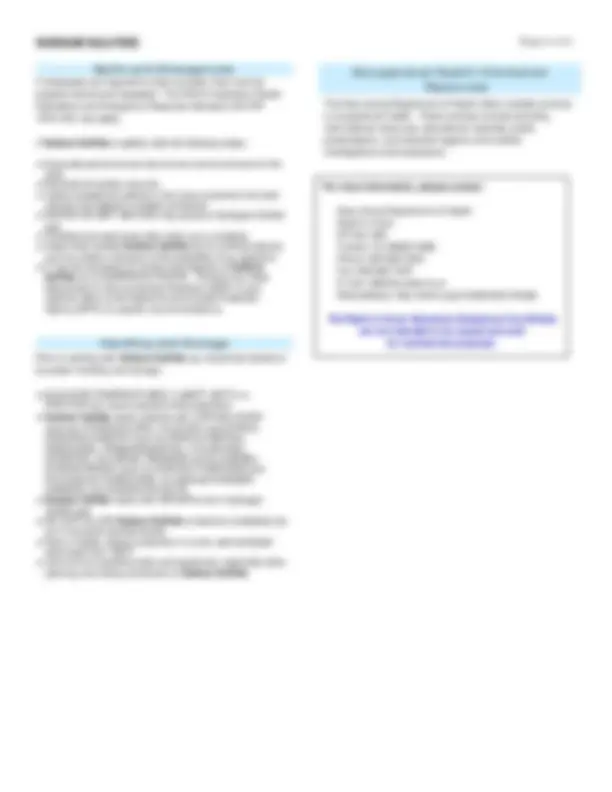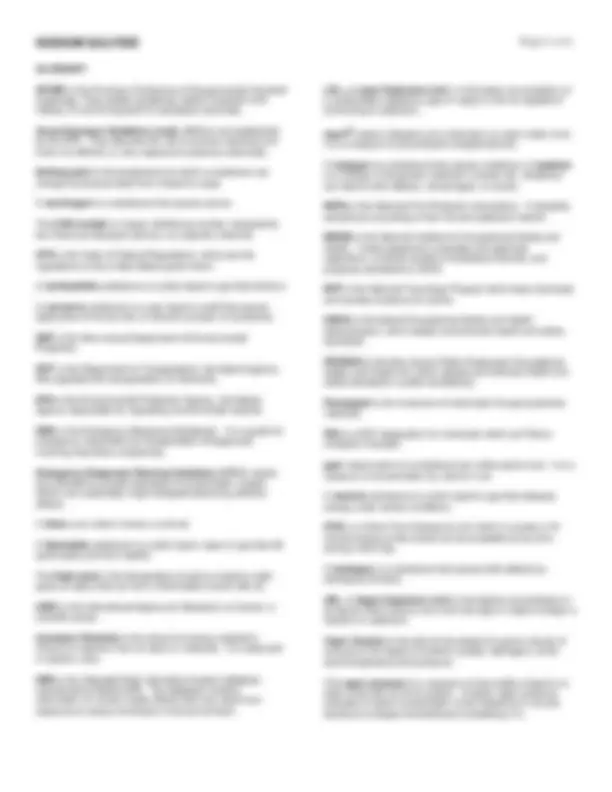





Study with the several resources on Docsity

Earn points by helping other students or get them with a premium plan


Prepare for your exams
Study with the several resources on Docsity

Earn points to download
Earn points by helping other students or get them with a premium plan
Community
Ask the community for help and clear up your study doubts
Discover the best universities in your country according to Docsity users
Free resources
Download our free guides on studying techniques, anxiety management strategies, and thesis advice from Docsity tutors
Information on the health hazards and safety measures related to Sodium Sulfide, a white, yellow to red or pink crystalline solid or flake with a rotten egg odor. It includes details on acute and chronic health effects, workplace exposure limits, and control measures.
What you will learn
Typology: Study notes
1 / 6

This page cannot be seen from the preview
Don't miss anything!




Synonyms: Sodium Monosulfide
Chemical Name: Sodium Sulfide
Date: August 1999 Revision: February 2008
CAS Number: 1313-82-
RTK Substance Number: 1728
DOT Number: UN 1385
Sodium Sulfide is a white, yellow to red or pink crystalline
solid or flake, which discolors on exposure to air and has a
rotten egg odor. It is used in the production of heavy water for
nuclear reactors, as a medication for animals, in dehairing
hides and making rubber, colors and dyes, and in pulp and
paper processing.
f Sodium Sulfide is on the Right to Know Hazardous Substance List because it is cited by DOT and NFPA.
f This chemical is on the Special Health Hazard Substance List.
Eye Contact f Immediately flush with large amounts of water for at least 30 minutes, lifting upper and lower lids. Remove contact lenses, if worn, while flushing. Seek medical attention immediately.
Skin Contact f Quickly remove contaminated clothing. Immediately wash contaminated skin with large amounts of soap and water. Seek medical attention.
Inhalation f Remove the person from exposure. f Begin rescue breathing (using universal precautions) if breathing has stopped and CPR if heart action has stopped. f Transfer promptly to a medical facility.
Poison Control: 1-800-222-
CHEMTREC: 1-800-424-
NJDEP Hotline: 1-877-927-
National Response Center: 1-800-424-
Hazard Rating NJDOH NFPA HEALTH (^) - 3 FLAMMABILITY - 1 REACTIVITY - 1 CORROSIVE SPONTANEOUSLY COMBUSTIBLE POISONOUS GASES ARE PRODUCED IN FIRE CONTAINERS MAY EXPLODE IN FIRE
Hazard Rating Key: 0=minimal; 1=slight; 2=moderate; 3=serious; 4=severe
f Sodium Sulfide can affect you when inhaled and may be absorbed through the skin. f Contact can severely irritate and burn the skin and eyes with possible eye damage. f Inhaling Sodium Sulfide can irritate the nose, throat and lungs causing coughing and/or shortness of breath. f Sodium Sulfide may cause a skin allergy. f Finely divided Sodium Sulfide may explode in air.
No occupational exposure limits have been established for Sodium Sulfide. However, it may pose a health risk. Always follow safe work practices.
f It should be recognized that Sodium Sulfide can be absorbed through your skin, thereby increasing your exposure.
f Read the product manufacturer’s Material Safety Data Sheet (MSDS) and the label to determine product ingredients and important safety and health information about the product mixture. f For each individual hazardous ingredient, read the New Jersey Department of Health Hazardous Substance Fact Sheet, available on the RTK website (www.nj.gov/health/eoh/rtkweb) or in your facility’s RTK Central File or Hazard Communication Standard file. f You have a right to this information under the New Jersey Worker and Community Right to Know Act, the Public Employees Occupational Safety and Health (PEOSH) Act if you are a public worker in New Jersey, and under the federal Occupational Safety and Health Act (OSHA) if you are a private worker. f The New Jersey Right to Know Act requires most employers to label chemicals in the workplace and requires public employers to provide their employees with information concerning chemical hazards and controls. The federal OSHA Hazard Communication Standard ( CFR 1910.1200) and the PEOSH Hazard Communication Standard (N.J.A.C. 12:100-7) require employers to provide similar information and training to their employees.
This Fact Sheet is a summary of available information regarding the health hazards that may result from exposure. Duration of exposure, concentration of the substance and other factors will affect your susceptibility to any of the potential effects described below.
Acute Health Effects The following acute (short-term) health effects may occur immediately or shortly after exposure to Sodium Sulfide :
f Contact can severely irritate and burn the skin and eyes with possible eye damage. f Inhaling Sodium Sulfide can irritate the nose, throat and lungs causing tightness in the chest and/or difficulty in breathing.
Chronic Health Effects The following chronic (long-term) health effects can occur at some time after exposure to Sodium Sulfide and can last for months or years:
Cancer Hazard f According to the information presently available to the New Jersey Department of Health, Sodium Sulfide has not been tested for its ability to cause cancer in animals.
Reproductive Hazard f According to the information presently available to the New Jersey Department of Health, Sodium Sulfide has not been tested for its ability to affect reproduction.
Other Effects f Sodium Sulfide may cause a skin allergy. If allergy develops, very low future exposure can cause itching and a skin rash. f Sodium Sulfide can irritate the lungs. Repeated exposure may cause bronchitis to develop with coughing, phlegm, and/or shortness of breath.
Medical Testing If symptoms develop or overexposure is suspected, the following are recommended:
f Evaluation by a qualified allergist can help diagnose skin allergy f Lung function tests
Any evaluation should include a careful history of past and present symptoms with an exam. Medical tests that look for damage already done are not a substitute for controlling exposure.
Request copies of your medical testing. You have a legal right to this information under the OSHA Access to Employee Exposure and Medical Records Standard (29 CFR 1910.1020).
Mixed Exposures f Smoking can cause heart disease, lung cancer, emphysema, and other respiratory problems. It may worsen respiratory conditions caused by chemical exposure. Even if you have smoked for a long time, stopping now will reduce your risk of developing health problems.
For more information, please contact:
New Jersey Department of Health Right to Know PO Box 368 Trenton, NJ 08625- Phone: 609-984- Fax: 609-984- E-mail: rtk@doh.state.nj.us Web address: http://www.nj.gov/health/eoh/rtkweb
The Right to Know Hazardous Substance Fact Sheets are not intended to be copied and sold for commercial purposes.
If employees are required to clean-up spills, they must be
properly trained and equipped. The OSHA Hazardous Waste
Operations and Emergency Response Standard (29 CFR
1910.120) may apply.
If Sodium Sulfide is spilled, take the following steps:
f Evacuate personnel and secure and control entrance to the area. f Eliminate all ignition sources. f Collect powdered material in the most convenient and safe manner and deposit in sealed containers. f WATER OR WET METHOD may produce Hydrogen Sulfide gas. f Ventilate and wash area after clean-up is complete. f Keep finely divided Sodium Sulfide out of confined spaces, such as sewers, because of the possibility of an explosion. f It may be necessary to contain and dispose of Sodium Sulfide as a HAZARDOUS WASTE. Contact your state Department of Environmental Protection (DEP) or your regional office of the federal Environmental Protection Agency (EPA) for specific recommendations.
Prior to working with Sodium Sulfide you should be trained on
its proper handling and storage.
f ELEVATED TEMPERATURES (1, o F, 920 o C) or FRICTION can cause explosive decomposition.
f Sodium Sulfide reacts violently with STRONG ACIDS (such as HYDROCHLORIC, SULFURIC and NITRIC); OXIDIZING AGENTS (such as PERCHLORATES, PEROXIDES, PERMANGANATES, CHLORATES, NITRATES, CHLORINE, BROMINE and FLUORINE); STRONG BASES (such as SODIUM HYDROXIDE and POTASSIUM HYDROXIDE); ALUMINUM POWDER; CARBON; and DIAZONIUM SALTS. f Sodium Sulfide reacts with WATER to form Hydrogen Sulfide gas. f DO NOT ALLOW Sodium Sulfide to become completely dry as it may ignite spontaneously. f Store in tightly closed containers in a cool, well-ventilated area away from HEAT. f Use only non-sparking tools and equipment, especially when opening and closing containers of Sodium Sulfide.
The New Jersey Department of Health offers multiple services in occupational health. These services include providing informational resources, educational materials, public presentations, and industrial hygiene and medical investigations and evaluations.
ACGIH is the American Conference of Governmental Industrial Hygienists. They publish guidelines called Threshold Limit Values (TLVs) for exposure to workplace chemicals.
Acute Exposure Guideline Levels (AEGLs) are established by the EPA. They describe the risk to humans resulting from once-in-a lifetime, or rare, exposure to airborne chemicals.
Boiling point is the temperature at which a substance can change its physical state from a liquid to a gas.
A carcinogen is a substance that causes cancer.
The CAS number is unique, identifying number, assigned by the Chemical Abstracts Service, to a specific chemical.
CFR is the Code of Federal Regulations, which are the regulations of the United States government.
A combustible substance is a solid, liquid or gas that will burn.
A corrosive substance is a gas, liquid or solid that causes destruction of human skin or severe corrosion of containers.
DEP is the New Jersey Department of Environmental Protection.
DOT is the Department of Transportation, the federal agency that regulates the transportation of chemicals.
EPA is the Environmental Protection Agency, the federal agency responsible for regulating environmental hazards.
ERG is the Emergency Response Guidebook. It is a guide for emergency responders for transportation emergencies involving hazardous substances.
Emergency Response Planning Guideline (ERPG) values are intended to provide estimates of concentration ranges where one reasonably might anticipate observing adverse effects.
A fetus is an unborn human or animal.
A flammable substance is a solid, liquid, vapor or gas that will ignite easily and burn rapidly.
The flash point is the temperature at which a liquid or solid gives off vapor that can form a flammable mixture with air.
IARC is the International Agency for Research on Cancer, a scientific group.
Ionization Potential is the amount of energy needed to remove an electron from an atom or molecule. It is measured in electron volts.
IRIS is the Integrated Risk Information System database maintained by federal EPA. The database contains information on human health effects that may result from exposure to various chemicals in the environment.
LEL or Lower Explosive Limit , is the lowest concentration of a combustible substance (gas or vapor) in the air capable of continuing an explosion.
mg/m^3 means milligrams of a chemical in a cubic meter of air. It is a measure of concentration (weight/volume).
A mutagen is a substance that causes mutations. A mutation is a change in the genetic material in a body cell. Mutations can lead to birth defects, miscarriages, or cancer.
NFPA is the National Fire Protection Association. It classifies substances according to their fire and explosion hazard.
NIOSH is the National Institute for Occupational Safety and Health. It tests equipment, evaluates and approves respirators, conducts studies of workplace hazards, and proposes standards to OSHA.
NTP is the National Toxicology Program which tests chemicals and reviews evidence for cancer.
OSHA is the federal Occupational Safety and Health Administration, which adopts and enforces health and safety standards.
PEOSHA is the New Jersey Public Employees Occupational Safety and Health Act, which adopts and enforces health and safety standards in public workplaces.
Permeated is the movement of chemicals through protective materials.
PIH is a DOT designation for chemicals which are Poison Inhalation Hazards.
ppm means parts of a substance per million parts of air. It is a measure of concentration by volume in air.
A reactive substance is a solid, liquid or gas that releases energy under certain conditions.
STEL is a Short Term Exposure Limit which is usually a 15- minute exposure that should not be exceeded at any time during a work day.
A teratogen is a substance that causes birth defects by damaging the fetus.
UEL or Upper Explosive Limit is the highest concentration in air above which there is too much fuel (gas or vapor) to begin a reaction or explosion.
Vapor Density is the ratio of the weight of a given volume of one gas to the weight of another (usually Hydrogen ), at the same temperature and pressure.
The vapor pressure is a measure of how readily a liquid or a solid mixes with air at its surface. A higher vapor pressure indicates a higher concentration of the substance in air and therefore increases the likelihood of breathing it in.